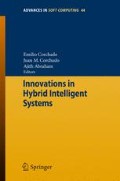Abstract
A general method to learn the inverse kinematics of multi-link robots by means of neuro-controllers is presented. We can find analytical solutions for the most used and known robots in the bibliography. However, these solutions are specific to a particular robot configuration and are not generally applicable to other robot morphologies. The proposed method is general in the sense that it is not dependant on the robot morphology. We base our method in the Evolutionary Computation paradigm for obtaining incrementally better neuro-controllers. Furthermore, the proposed method solves some very specific issues in robotic neuro-controller learning. (1) It allows to escape from any neural network learning algorithm which relies on the classical supervised input-target learning scheme and hence it lets to obtain neuro-controllers without providing targets or correct answers which -in this case- are un known in prior. (2) It can converge beyond local optimal solutions which is one of the main drawbacks of some neural-network training algorithms based on gradient descent when applied to highly redundant robot morphologies. (3) Using learning algorithms such as the Neuro-Evolution of Augmenting Topologies (NEAT) it is also possible learning the neural network topology on-the-fly which is a common source of empirical testing in neuro-controllers design. Finally, experimental results are provided by applying the method in two multi-link robot learning tasks with a comparison between fixed and learnable topologies.
Access this chapter
Tax calculation will be finalised at checkout
Purchases are for personal use only
Preview
Unable to display preview. Download preview PDF.
References
J. Denavit and R. Hartenberg. A kinematic notation for lower-pair mechanisms based on matrices. ASME J. Applied Mechanics, pp. 215–221, June 1955.
P.J. Angeline, G.M. Saunders, and J.B. Pollack. An evolutionary algorithm that constructs recurrent neural networks. IEEE Trans. Neural Networks, 5(1):54–65, 1994.
N. Hansen and A. Ostermeier. Adapting arbitrary normal mutation distributions in evolution strategies: The covariance matrix adaptation. In Int. Conf. on Evolutionary Computation, pp 312–317, 1996.
K.O. Stanley and R. Miikkulainen. Evolving neural networks through augmenting topologies. Evol. Comput., 10(2):99–127, 2002.
Author information
Authors and Affiliations
Editor information
Editors and Affiliations
Rights and permissions
Copyright information
© 2007 Springer-Verlag Berlin Heidelberg
About this chapter
Cite this chapter
Martín, J.A.H., de Lope, J., Santos, M. (2007). Evolution of Neuro-controllers for Multi-link Robots. In: Corchado, E., Corchado, J.M., Abraham, A. (eds) Innovations in Hybrid Intelligent Systems. Advances in Soft Computing, vol 44. Springer, Berlin, Heidelberg. https://doi.org/10.1007/978-3-540-74972-1_24
Download citation
DOI: https://doi.org/10.1007/978-3-540-74972-1_24
Publisher Name: Springer, Berlin, Heidelberg
Print ISBN: 978-3-540-74971-4
Online ISBN: 978-3-540-74972-1
eBook Packages: EngineeringEngineering (R0)

